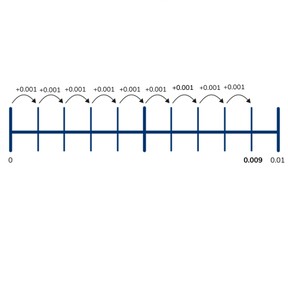
Place value- decimal numbers with 3 decimal places on the number line
Place value- decimal numbers with 3 decimal places on the number line



8,000 schools use Gynzy
92,000 teachers use Gynzy
1,600,000 students use Gynzy
General
Students learn to place decimal numbers with 3 decimal places on the number line.
Common core standard(s)
CCSS.Math.Content.5.NBT.A.3
Relevance
It is important to be able to place numbers on the number line to be able to know where a number belongs, be able to compare, and know if a number is less or greater than a given number.
Introduction
Start by having students match inhabitant numbers to countries. Ask them to say the numbers out loud. (Netherlands 17.205 million, Italy 60.592 million, Belgium 11.325 million, USA 325.689 million). Then complete the number sequences where 0.01 is added. You then work with a number line from 8 to 9 with 10 marks, and each mark represents 0.1. This is to prepare for decimal numbers with 3 decimal places.
Instruction
Tell students that you must always look at the starting number and the final number of a number line so you know what the range of a number line is. Then you count the number of marks on the number line. In this case the number line goes from 0.01 and has 10 marks. 0.01 : 10 = 0.001, so every mark represents 0.001. If you know this, you can place a number accurately on the number line. Practice this with students on a number line form 0 to 0.1. Next show a number line that has 100 marks, with every mark representing 0.01. Tell students that when you want to place a number on the number line, like 0.023, it is useful to find the neighboring hundredths, in this case 0.02 and 0.03. Then you count the smallest marks and know where the number belongs. Practice this with students using different decimal numbers with three decimal places. First write the hundredths on the number line. This helps to see where the numbers belong. 0.01, 0.02, 0.03, 0.04...0.1. Next show a number line without any intermediate marks. You cannot count tenths or hundredths. It is important for students to imagine marks on the number line. Find the middle, and determine where to approximately place the number.
Check that students understand placing decimal numbers with 3 decimals on the number line by asking the following questions:
- What are the neighboring hundredths numbers of 0.067?
- Which number is exactly in the middle between 4.6 and 4.7?
- Which number is exactly in the middle between 4.62 and 0.63?
Guided practice
Practice with students placing numbers on the number line with 10 intermediate marks. Then on a number line with 100 marks. They then must approximately place numbers on the number line.
Closing
Repeat the steps of placing a decimal number on the number line with your students. First look at the starting number and the final number of the number line. Then you look at the marks or imagine marks on your number line, so you know what the marks represent. Then you look for the neighboring hundredths or tenths of your number. Ask students to explain these steps. Check with a final exercise in which students must set decimal numbers with 3 decimal places on the number line. Ask students which number belongs at the question mark, which number is in the middle and where 5.539 is on the number line. Have them explain their thinking. Finish with a number line with 100 marks from 0.0.1, and have students say where the given numbers belong. Have them recognize that writing hundredths first is useful.
Teaching tips
Students who are not as comfortable with the number line can be confused by the changes of starting and final numbers, as well as the changes in value of intermediate marks. Take time to review the steps with the students and emphasize the importance of determining the starting and final numbers of the number line, and taking the time to determine the value of the intermediate marks. You can also have them practice on a number line to 100, telling them that the only difference is that a decimal point is in the number.
The online teaching platform for interactive whiteboards and displays in schools
Save time building lessons
Manage the classroom more efficiently
Increase student engagement
Discover more!
About Gynzy
Gynzy is an online teaching platform for interactive whiteboards and displays in schools.
With a focus on elementary education, Gynzy’s Whiteboard, digital tools, and activities make it easy for teachers to save time building lessons, increase student engagement, and make classroom management more efficient.



